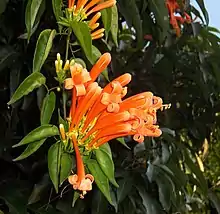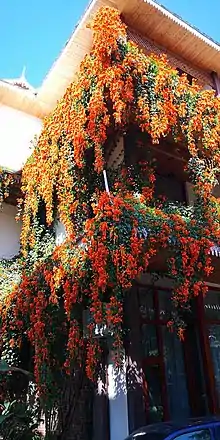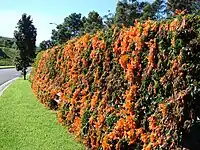Pyrostegia venusta
Pyrostegia venusta, also commonly known as flamevine[2] or orange trumpet vine,[3] is a plant species of the genus Pyrostegia of the family Bignoniaceae originally native to southern Brazil, Bolivia, northeastern Argentina and Paraguay; today, it is also a widely cultivated garden species.[3][4]
| Pyrostegia venusta | |
|---|---|
 | |
| Scientific classification | |
| Kingdom: | Plantae |
| Clade: | Tracheophytes |
| Clade: | Angiosperms |
| Clade: | Eudicots |
| Clade: | Asterids |
| Order: | Lamiales |
| Family: | Bignoniaceae |
| Genus: | Pyrostegia |
| Species: | P. venusta |
| Binomial name | |
| Pyrostegia venusta | |
| Synonyms[1] | |
| |

Description
It is an evergreen, vigorously-growing climber, capable of reaching 5 m in height. The foliage is made up of opposite, pinnate leaves with two or three, 4 to 8 cm leaflets,, and a 3-branched tendril, which all arise together from the end of the leaf petiole.[5]
The orange flowers, which appear from winter to spring, are 5 to 9 cm long and densely clustered. They are pollinated by hummingbirds. The fruits are smooth, 3 cm long brown capsules.
Cultivation
The plant is sensitive to cold winds and prefers sunny, sheltered locations. Its frost hardiness USDA zones are 9 to 11. It is resistant to soil salinity.
The plant has forked tendrils, which will cling to any rough surface, including brick walls. It can be grown from semi-hardwood cuttings taken in summer, autumn or winter.
It is naturalised in eastern Australia, eastern Africa and in the southeastern United States.[6]
Taxonomic history
The species was first described by John Miers in 1863.
Etymology
Venusta means 'beautiful', 'charming', or 'graceful'.[7] "Pyrostegia" is from the Greek pyros 'fire', relating to the colour of the flowers and the shape of the upper lip, and stegia 'covering'. When the flowers cover a building, it may appear to be on fire.

References
- The Plant List: A Working List of All Plant Species, retrieved 8 September 2016
- USDA, NRCS (n.d.). "Pyrostegia venusta". The PLANTS Database (plants.usda.gov). Greensboro, North Carolina: National Plant Data Team. Retrieved 16 October 2015.
- "Pyrostegia venusta". Germplasm Resources Information Network. Agricultural Research Service, United States Department of Agriculture. Retrieved 7 October 2006.
- Proceedings of the Royal Horticultural Society of London 3:188. 1863
- Orange Trumpet Creeper by Burke's Backyard
- Pyrostegia venusta by Weeds of Australia - Biosecurity Queensland Edition
- Gledhill, David (2008). "The Names of Plants". Cambridge University Press. ISBN 9780521866453 (hardback), ISBN 9780521685535 (paperback). pp 322, 399